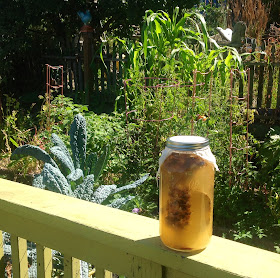What is Tepache?
Tepache is a fermented pineapple drink popular in Mexico. Originally made with corn, tepache is a nahuatl word derived from tepiatl (meaning "drink of corn"). Today, tepache is generally made with pineapple rinds, which ferment to produce a tart and refreshing drink.
Tepache Recipe
Ingredients
- The skin of one pineapple
- 4 cones of pilloncillo
- 4 cloves
- 1 stick of cinnamon (preferably Mexican canela or Ceylon cinnamon)
- Approx. 6 cups filtered water
Wash pineapple well and then cut away the skin. Eat the delicious pineapple as you won't be using it in this recipe!
Bring water to a boil and add cinnamon, cloves, and pilloncillo. Stir until pilloncillo dissolves. Turn off heat and allow mixture to cool COMPLETELY.
Put pineapple peel and cooled water mixture (with cinnamon and cloves) in a large jar. You want the jar to be full so add more water if necessary. Cover jar with a piece of cloth tied with rubber band (or canning lid with center removed as pictured below).
Put the jar in a warm sunny place. I put mine outside. Wait several days until bubbles start to form. Taste. You want a kombucha-like flavor—a bit tangy. If the taste is still overwhelmingly sweet, it is not done. Wait a few more days and taste again...Depending on the weather and other factors it can take anywhere from 3-10 days to get your brew going. You need to taste it regularly.
Once you get the flavor you want, strain the tepache and put it in the refrigerator. I like to let the tepache "rest" in refrigerator a few days before drinking as I think the flavor continues to develop and mellow.
To serve, you can add sweetener or some lime juice as desired. It tastes best with ice. If it is too strong, you can water it down a bit.
NOTE: Don't throw away the pineapple rind after making the tepache. You can make another batch of tepache with the same rinds! The second batch is often even more tasty than the first. You can even try a third batch, but you start to get diminishing returns.
What is fermentation? (Food as Magic)
Fermentation occurs when the the sugars and carbohydrates in a food convert into something else. For instance, juice when fermented can turn into into wine, grains can turn into beer, and carbohydrates turn into carbon dioxide to leaven bread.
In short, fermentation is alchemy, that is "a power or process that changes or transforms something in a mysterious or impressive way."
What are health benefits for fermented foods?
[Quotes from Washington Post]
- "Fermented foods aid in digestion and thus support the immune system."
- "Imagine a fermented food as a partially digested food. For instance, many people have difficulty digesting the lactose in milk. When milk is fermented and becomes yogurt or kefir, the lactose is partially broken down so it becomes more digestible."
- "Organic or lactic-acid fermented foods (such as dill pickles and sauerkraut) are rich in enzyme activity that aids in the breakdown of our food, helping us absorb the important nutrients we rely on to stay healthy."
- "Fermented foods have been shown to support the beneficial bacteria in our digestive tract. In our antiseptic world with chlorinated water, antibiotics in our meat, our milk and our own bodies, and antibacterial everything, we could use some beneficial bacteria in our bodies."
- "When our digestion is functioning properly and we are absorbing and assimilating all the nutrients we need, our immune system tends to be happy, and thus better equipped to wage war against disease and illness."


No comments:
Post a Comment